If you have been tasked with hosting your family’s Thanksgiving holiday, then you are most likely extremely concerned and stressed about cooking the turkey. The roast turkey is the centerpiece of the meal; the reason, daresay, why everyone has gathered together in anticipation of a delectable dinner. As the host, the last thing you want to do is botch the turkey. I promise you right now that you can master this intimidating feat if you follow a few simple steps below with the best roast turkey and brine recipe ever!
The ultimate question of cooking Thanksgiving turkey: To brine, or not to brine? I have always, and will always, fall smack dab in the middle of the “brine” category. I have found that a good brine can make all the difference in both flavor and texture when cooking your bird. The brine can add a subtle seasoning to the meat while enhancing the natural, delicious flavor turkey has inherently. It is also the number one way to ensure you don’t end up with dry meat. (No one wants turkey that has the texture of old cardboard!)

I brine my bird regardless of how I choose to cook it (roasted in the oven or deep fried). If you are new to brining, there are a few key points to keep in mind when brining and cooking your turkey:
#1: Never, ever, ever put your turkey in a brine that is still hot! Failing to follow this rule is a great way to give your guests food poisoning, so please do everyone a favor and make sure the brining liquid is very cold before you put in the poultry.
#2: Brining bags can be expensive, difficult to find, and a bit on the flimsy side, so I did a little Thanksgiving jig when I discovered Extra Large Ziploc bags a few years ago. They are the perfect size for brining your turkey! I found mine at K-Mart, but you can get them at most stores or online at Amazon.
#3: After you remove your turkey from the brining liquid, make sure you rinse the exterior of the bird and inside the cavity to prevent it from becoming too salty.
#4: No matter what method you use to cook your bird, make sure it is totally dry first. This will make sure you have a lovely crisp skin.
#5: I’m not positive why, but I have found my cooking time drastically reduced after brining my turkey. I think it has something to do with the fact that brining infuses a lot of salt into the meat and since salt is a heat conductor, it cooks the meat faster. Regardless of the actual science behind why, I have found that a brined turkey will cook 1-2 minutes a pound faster than a non-brined bird. (This is using the assumption that unbrined turkeys cook at approximately 13 minutes a pound, so assume a brined bird will take 11-12 minutes a pound.)
#6 (as mentioned in the comments section by Harley) Make sure your turkey is a “natural” bird. You never want to brine a turkey that is labeled “pre-basted”,” self-basting,” or “Kosher.” This is because these types of bird have already been soaked in a salt solution and adding an additional soak in brining liquid would create a flavor similar to a salt lick!
OK, now that you are armed with the basic rules of brining, let’s get to cooking the best roast turkey and brine recipe ever! Happy Turkey Day everyone!
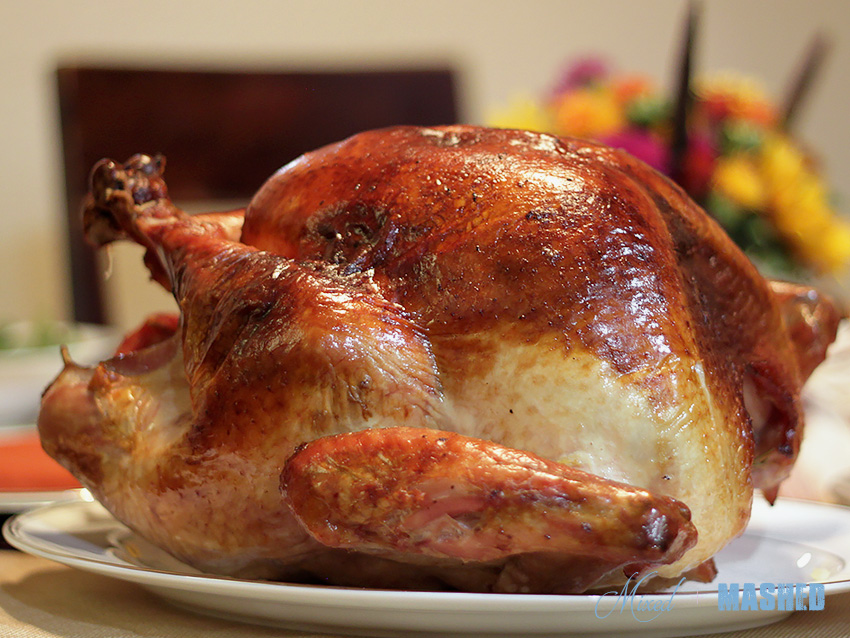
The Best Roast Turkey and Brine Recipe Ever
Ingredients for the Brine: Recipe adapted from Alton Brown’s Good Eats Roast Turkey
Note: You will brine your turkey the day before you intend to cook it, so please plan accordingly
- 1 gallon (16 cups) chicken stock
- 1 cup apple juice

- 1 cup coarse Kosher salt
- ½ cup light brown sugar
- ½ cup granulated sugar
- 1 onion, quartered
- 2 carrots, peeled and cut in half
- 2 celery stalks, cut in half
- 4 cloves garlic, whole
- Handful of fresh thyme
- 7 sprigs of fresh sage
- Small handful of fresh parsley
- 1 sprig fresh rosemary
- 1 tablespoon whole peppercorns
- 2 bay leaves
- 1 ½ teaspoons whole allspice berries
- 1 ½ teaspoons chopped candied ginger (I have used fresh ginger if unable to find candied)
- 1 gallon ice water (16 ounces)
- 4 cups of ice
- 1 turkey, approximately 15 pounds, giblets removed (If you are not using fresh, make sure the turkey is thoroughly thawed. You can always use a bigger bird if necessary; just adjust your cooking time appropriately.)
- 1 large brining bag
Ingredients for the Roast Turkey adapted from Martha Stewart’s Perfect Roast Turkey
- 1 stick of butter, softened
- 1 stick of butter, melted
- 1 cup dry white wine, room temperature (like chardonnay or sauvignon blanc)
- Cheesecloth (found in the grocery store aisle near kitchen utensils)
Instructions for the Brine:
- The day before you plan to cook your turkey, make the brine. Pour the chicken stock into a large stock pot and add the apple juice, salt, brown sugar, granulated sugar, onion, carrots, celery, garlic, thyme, sage, parsley, rosemary, peppercorns, bay leaves, allspice, and ginger. (Basically everything except the ice water, ice and turkey!) Bring to a simmer over high heat, stirring occasionally until the sugar and salt dissolve.

- Remove from heat once it begins to simmer and allow to cool for at least 30 minutes to one hour. Pour the cooled brine into your brining bag and add the ice water. Add in additional cups of ice until the liquid is very cold, stirring to make sure it is cooled throughout the brine.
- Only once the liquid is very, very cold, add your turkey to the brine breast-side down. Seal the bag, squeezing out as much air as possible. If you have a lot of excess bag space, tie it into a knot using a rubber band. Place the turkey in a large roasting pan with high sides (or a bucket) and store overnight in your fridge.
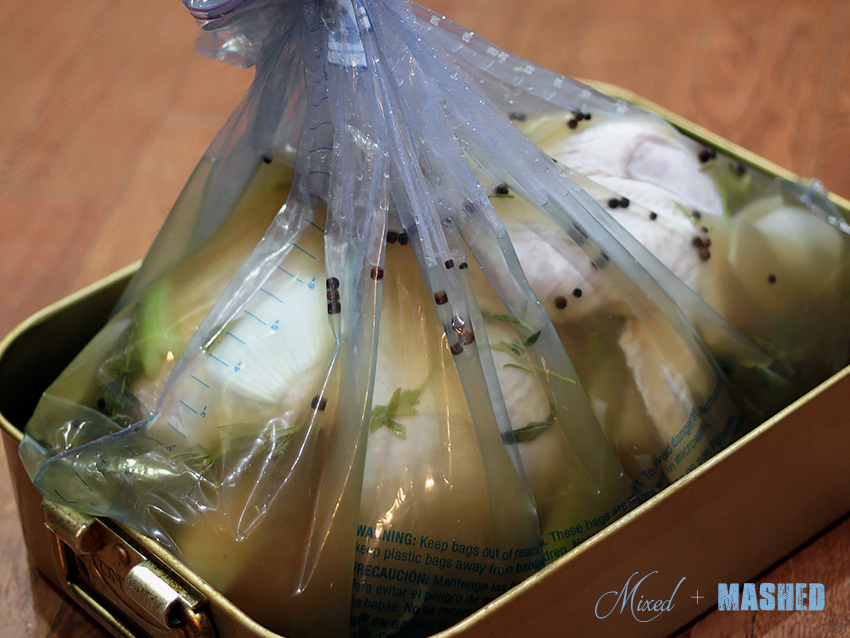
Instructions for Roasting the Turkey
- Remove your turkey from the brine at least 1 hour before you intend to cook it. Discard the brine and rinse the bird well to remove any excess salt. Let stand at room temperature for approximately one hour to dry the skin and take the chill off the turkey. Make sure you thoroughly dry the turkey inside the cavity and all over the exterior of the bird.
- Preheat the oven to 450 degrees.
- Gently loosen the skin from the breast meat. This will be much more difficult than it is with a chicken, so don’t be afraid to use some force to tear through the fibrous pieces. Take approximately ¼ of the softened butter stick and rub it between your hands. Then massage the butter all over the turkey skin. Take another third of the stick and do the same thing, but getting underneath the skin as much as possible. Distribute the remaining 1/3 stick of butter where ever needed on the turkey. It’s OK to have larger butter chunks under the skin.
- Place the turkey, breast-side up, in a large roasting pan with a rack inside. Tie the legs together with twine and push the wings underneath the turkey so that it looks like it is sunbathing.
- Open up the cheesecloth all the way and gently drape it over the turkey. Trim the cloth so that there is minimal overhang into the pan. You want the cheesecloth the completely cover the turkey.
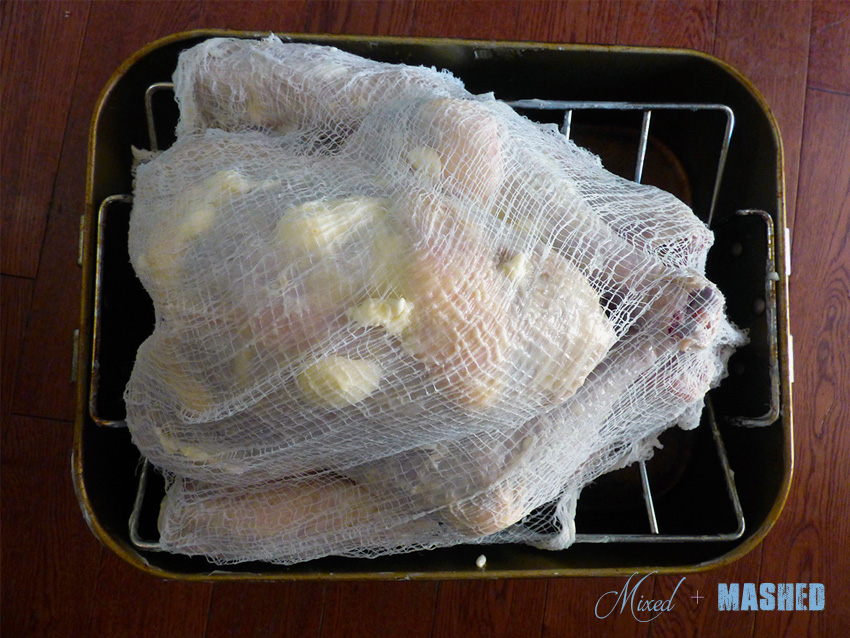
- Combine the melted butter and the cup of wine in a medium size bowl. Take the cheesecloth you trimmed to fit the turkey and place it inside the bowl, saturating the cloth with the wine-butter liquid. Remove the cheesecloth and squeeze most of the excess liquid back into the bowl. Gently drape the cheesecloth over the turkey again. Using a turkey baster, baste the bird once with the wine-butter mixture, making sure it goes directly on top of the cheesecloth. (The cheesecloth with ensure that you don’t overbrown the bird while it is cooking in the oven.) Reserve the remaining wine-butter liquid for additional basting.
- Place the cheesecloth covered turkey in the oven and cook undisturbed for 45 minutes. Then turn the temperature down to 350 degrees and baste the wine-butter mixture all over the breast. Continue to do this in 45 minute increments until the an instant read thermometer says the internal temperature is 165 degrees. Note: Be sure to remove the cheesecloth before the final cooking increment to allow the turkey to properly brown in the oven. If your turkey has already come to temperature and you still need to brown the skin, you can turn on the broiler for a few short minutes. Just make sure you are constantly watching the skin to ensure it doesn’t burn. Also, if you run out of wine-butter basting liquid mid-way, use the drippings in the bottom of the pan and inside the cavity to baste the bird.
- Remove your turkey from the oven and very loosely tent it with aluminum foil, making sure it doesn’t touch the skin. Allow the turkey to stand at room temperature for 45 minutes so the juices can redistribute throughout the bird. Then carve and serve. Happy Turkey Day!!
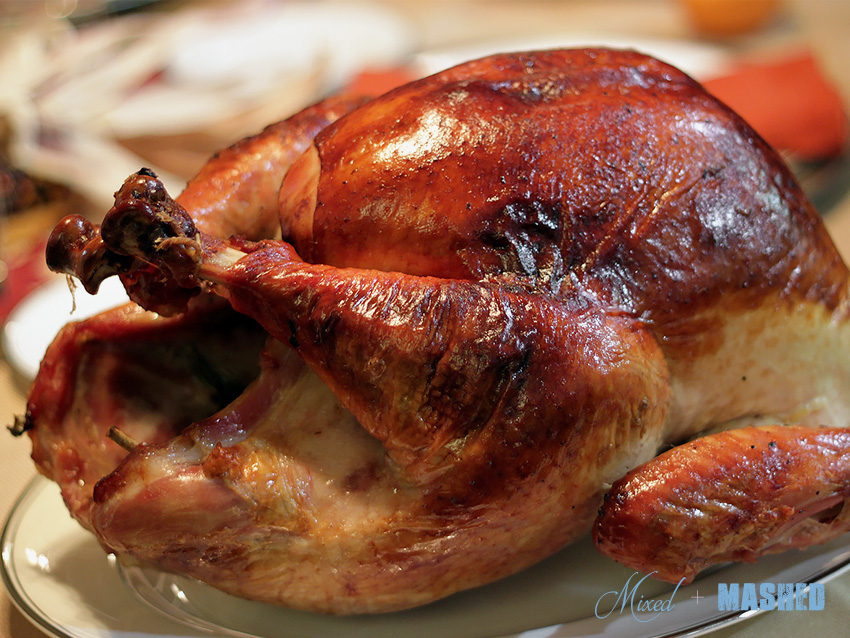



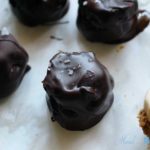
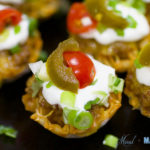
2 comments
Don’t brine a pre-basted or self-basting turkey. They turn out way to salty.
That is absolutely correct, Harley! Pre-basted or self-basting turkeys are already brined, so you would never want to brine a pre-brined bird. I do not recommend purchasing a pre-brined turkey because you have no control as to what additional flavors were added or how much sodium was used. You will almost always have better results making the brine yourself. I will make sure to add this note to the post itself. Thank you for the comment!